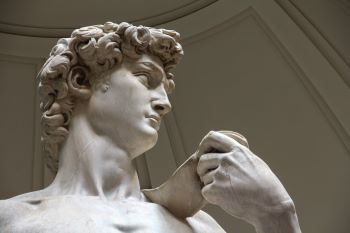





The Accademia di Belle Arti art museum in Florence is also known as the Accademia or Galleria dell’Accademia. The Accademia was the first academy for painters in Europe, founded in 1563 during the heyday of the Medici dynasty. With 7 statues, the Accademia has the largest collection of sculptures by Michelangelo in the world, including the famous statue of David. The collection of gold-ground paintings from the 13th to the early 15th century is unique, with examples of paintings by the greatest Florentine artists such as the Master of Mary Magdalene, Giotto, the Master of Santa Cecilia, Bernardo Daddi, Taddeo Gaddi, Andrea Orcagna and many others. No less rich is the field of 15th century painting, which represents late Gothic and Renaissance art. Renaissance painting is represented by works by Paolo Uccello, Sandro Botticelli, Domenico Ghirlandaio and Filippino Lippi.
The statue of David is regarded as the perfect ideal of male beauty in art and, like Botticelli’s Venus, is considered a standard work. Artists and art experts consider the David to be the most beautiful man-made object in art.
Immerse yourself in a fascinating 9-minute VR experience that transports you to Renaissance Florence. Experience Michelangelo's famous David statue up close and personal and hear the voice of the master himself, revealing the secrets of his masterpiece.
Highlights of the VR tour
Enter Michelangelo's workshop and admire the David up close
Listen to Michelangelo's stories about the creation process
Discover the finest details of the sculpture, which are barely visible to the naked eye
Learn about the symbolism and meaning of David
A unique art experience
As soon as you put on the VR headset, you will find yourself in Michelangelo's dusty workshop. The imposing David stands before you – so close that you can see every vein and fold in the marble. Then you will hear Michelangelo's voice, taking you on an emotional journey.
He shares his struggles, doubts and passions
explains the significance of every detail of the statue
and lets you feel the soul of his creation.
More than just looking
This VR experience doesn't just let you see the David, it lets you truly understand and feel it. You'll have a personal conversation with the genius Michelangelo and gain deep insights into his masterpiece.
Important information
The selected day and time correspond to the day and time of entry to the Galleria dell'Accademia. You then have two days to experience the VR experience.
You can do the VR experience at the Slow Tour Tuscany Office at Lungarno degli Acciaiuoli 10, 50123 or at the Slow Tour Tuscany Office at Via degli Alfani 113 rosso, 50122 Firenze FI, Italy

Clickhere
to see on google maps
Address:
Accademia di Belle Arti,
Via Ricasoli 58-60,
50122 Firenze FI
Your ticket for the Galleria dell’Accademia is already included in your City Pass.